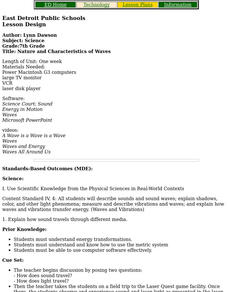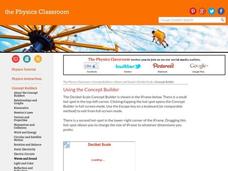Teach Engineering
Acoustic Mirrors
Investigate sound waves with acoustic mirrors. Using audio software, groups make recordings of musical instruments, both with and without acoustic mirrors. They compare the recordings to see the effect of acoustic mirrors on sound waves.
University of Waikato
Make and Use a Hydrophone
Using a home-built hydrophone, pupils investigate how things sound in water. Learners listen to sounds created in air and then compare that to the same sound picked up by the hydrophone. Individuals compare the loudness and the pitch of...
Explore Sound
Sound and Music
What causes sound? Groups of sound detectives use a variety of tools including ping pong balls, pasta noodles, raisins, rubber mallets, and a tuning fork to investigate what causes sound. The young Sherlocks conduct a series of...
Institute of Electrical and Electronics Engineers
Engineered Music
Sound engineers investigate the structural design of a musical instrument, the recorder. They work in collaborative groups to choose an instrument to build out of everyday craft materials. It must be able to repeat a three-note sequence...
Curated OER
Chandra Spies the Longest Sound Wave in the Universe!
In this black hole learning exercise, students use an x-ray image and a sound waves image to determine the size and the wavelength of the sound wave. This learning exercise has 3 problems to solve.
Virginia Department of Education
Sound
Add a little music to your next physics class. Pupils discuss how frequency determines pitch and take part in several activities designed to teach them more about sound, melody, resonance, and vibrations. They use materials to construct...
Columbus City Schools
Making Waves
Learning about waves can have its ups and downs, but a demo-packed tool kit has the class "standing" for more! Learners gain experience with several different wave types, organizing observations and data, and wave terminology. The...
Physics Classroom
Name That Harmonic: Strings
Don't string your class along! Physics scholars discover the fascinating forces behind the music of stringed instruments using an interactive. From a series covering sounds and waves, the interactive asks users to identify nodes and...
PBS
Volume and Amplitude | UNC-TV Science
Future physicists pump up the volume while discovering the world of sound waves. Group members learn about the qualities of sound waves, the relationship between energy and sound volume, and the definition of amplitude while viewing an...
CK-12 Foundation
Seafloor: Sonar Boats
An interactive that teaches about sonar sure sounds like fun! Junior oceanographers study the uses of sonar, past and present, in an engaging interactive. The content demonstrates how sonar works, why sound waves are a great tool for...
PBS
Longitudinal Waves | UNC-TV Science
Discover whether sound travels in space and other fascinating science facts. Scientists explore energy transfer by longitudinal waves and learn about compression, rarefaction, amplitude, and wavelength while watching an animated video....
Curated OER
What Does Motion Have to do with Sound?
Second graders investigate and explore sound energy. They investigate how the vibrational motion moves through matter in waves. Students describe sounds and vibrations. They observe that vibrational motion creates sounds. Students record...
Curated OER
Good Vibrations: Building a Wave Model
Students assess and apply recurring patterns in natural systems. They evaluate the wave properties of frequency, wavelength, and speed as applied to sound. Students develop a relationship to quantify aspects of wave motion. They predict...
Mr. E. Science
Sound
Since light travels faster than sound, some people may appear bright until you hear them speak. The presentation covers what sound is, how fast it travels in various mediums, properties of sound, hearing, and the parts of the human ear.
Curated OER
Nature and Characteristics of Waves
Seventh graders research different types of waves, identify the parts of a wave and create a Power Point presentation demonstrating what they have learned.
Curated OER
Waves
In this wave worksheet, students will review the characteristics of waves which includes the parts of a wave, how waves are measured, and how waves are created. This worksheet has 8 vocabulary used in a word puzzle, 5 true or false, and...
Curated OER
Hear the Wave!
Students study sound and ear function. For this sound functions lesson, students investigate soundwaves by completing various experiments. Students participate in a number of sound stations and complete the comparison chart with their...
Curated OER
How the Ear Receives Sound
In this biology worksheet, students identify how the ear receives sound by using the information given to cut and paste each section to complete a flow chart that illustrates this. They lightly color each section of the flow chart to...
Curated OER
Sounds Like Science-Guitars
Students demonstrate the relationship between a sound and its frequency. For this sound and frequency lesson, students use an old tennis racket and nylon fishing line to create a guitar. Students observe the pitch and frequency.
Curated OER
Sounds Like Science - Drums
Young scholars see that understanding how sound is produced makes it possible for us to manipulate it so we can decrease the number of unpleasant sounds we encounter. They make a drum to explore the concepts of force, pitch and volume.
Physics Classroom
Name That Harmonic: Open-End air Columns
Ever wonder what really goes on inside a clarinet? Show your young scientists the physics of open-end air columns through an easy-to-use interactive. Learners examine the features of standing waves and calculate frequency and length in a...
Physics Classroom
Name That Harmonic: Closed-End air Columns
Physics is like music—practice makes perfect! Challenge your class using an interactive that builds harmonic skills. The engaging lesson from a playlist exploring sounds and waves revolves around wave behavior in closed-end air columns....
Physics Classroom
Decibel Scale
Turn it up! Sound scientists explore the decibel scale through an interactive that calculates movement up and down the scale. Part of a series of interactives that explore sounds and waves, the resource includes a help feature to support...
Acoustical Society of America
Good Vibrations
Visualize vibrations within the classroom. Pupils see the connection between sound and waves. The learners use a tuning fork in two different ways to demonstrate the waves associated with sound. Scholars see how the sound waves from a...
Other popular searches
- Light and Sound Waves
- Sound Waves & Music
- Physics Sound Waves
- Sound Waves Physics
- Worksheet Sound Waves
- Light & Sound Waves
- Speed of Sound Waves
- Sound Waves Amplitude
- Vibration and Sound Waves
- Sound Waves and Guitars
- Sound Waves Webquest
- Light Sound Waves

























